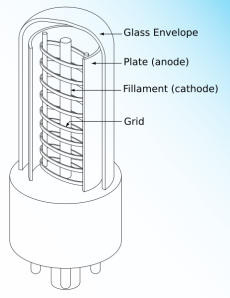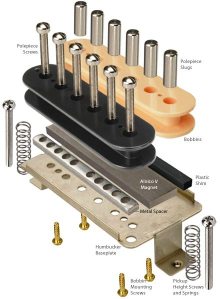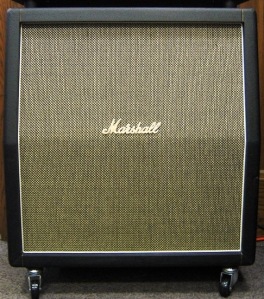There is a lot of misunderstanding among guitarists regarding exactly how Class A, Class A/B, cathode-bias and fixed-bias amps operate and differ from one another. The following post addresses this topic thoroughly. First it is important to clarify the fundamentals of how a guitar tube (valve) actually operates.
How a Vacuum Tube Actually Operates
The crucial functioning components of a tube (see above illustration) are the control grid, the cathode and the plate. These three components are the functioning parts of a triode tube. Note that there are other common guitar amplifier tubes called tetrodes and pentodes as well, and these tube types feature extra grid components called a screen grid and suppressor grid respectively. For the sake of addressing the most important fundamentals of tube operation, we’ll keep the scope of the following information to triode tubes.
Within a triode tube the plate has a positive charge, which attracts electrons. The grid is the audio input to the tube and controls the flow of electrons. There is a high voltage on the plate of the tube and a heated cathode that emits negative electrons (called thermionic emission—a main component of the “magic” of tubes). Because of thermionic emission, heat from the filament causes free electrons to boil off of an oxide coating on the cathode. Voltage on the plate attracts the electrons from the cathode, and the moving electrons produce a current flow.
Amplification happens when a signal is applied to the grid and flows through to the plate. Because the signal voltage is relatively low and the plate current is relatively high, small changes produced by the audio signal at the grid become much larger at the plate and amplify. That flow needs to be “controlled” somehow, which is accomplished via biasing. A tube cannot tell the difference between having the grid negative (fixed-bias) relative to the cathode or the cathode positive (cathode-bias) relative to the grid. A tube has no idea what class it’s operating in—a change in input voltage yields a change in plate current regardless of class. So output can swing the same amount in either direction before clipping. The limits of the power supply, and the idle point of the triode in a tube amp, determine whether “cutoff” or “clipping” will occur and the level of symmetry or asymmetry of the wave shape.
It’s important to note where in your arsenal of equipment you can find this small fluctuating AC voltage that controls this plate current—at the other end of the guitar cord via the guitar pickups. So what happens when you take this plate current and plug it into a speaker? The large current flowing through the plate fluctuates with the same frequency as the small guitar pickup voltage, and the tones we love come through. Hence, the tube amplifies the guitar signal. It makes the small AC signal coming from your guitar pickups big enough to move a speaker cone.
Cathode-Bias
In Class A cathode-bias current flowing through the tube flows through the cathode resistor, developing a slightly positive voltage at the cathode, so the cathode is positive relative to the grid. Current is flowing at all times. Because there is no current flowing through the grid and resistors, the grid is grounded at zero volts. In addition, the positive voltage at the plate is lessened by the slightly positive voltage at the cathode, as the tubes only see the difference between the cathode voltage and plate voltage. Positive cathode-bias is developed by drawing current through the cathode resistor.
Let’s assume that a tube needs the grid to be at -2 volts. That means that the cathode is at 0 volts and the grid is at -2 volts. Now suppose we add 2 volts to both values. The grid voltage becomes 0 volts and the cathode voltage becomes +2 volts. The grid is still -2 volts away from the cathode, which is required.
By biasing some DC voltage has been established on the grid (negative voltage for fixed-bias or 0V DC for cathode-bias). When the AC signal is added from guitar pickups, it can be thought of as an AC signal with a DC offset. In the cathode-biased model, the AC is oscillating around ground (going positive and negative). In the fixed-bias model, the AC signal is oscillating around the negative bias voltage (going less negative and more negative). That said, it should be clear that you’ve always got some DC offset to the AC signal (even if it is zero), and applying AC signal is the equivalent of varying the DC up and down—turning the tube “more on” and “more off” as it oscillates.
As current starts to flow, a voltage drop is created across the cathode resistor, which raises the DC voltage of the cathode. Because the grid is at 0 volts (DC), the grid is now negative with respect to the cathode and that controls the flow. If put in a tube that wants to run “hot,” the extra current simply increases the voltage drop across the cathode resistor and that tends to self-correct. In a cathode-biased amp, tubes with a fairly wide range of parameters will bias very similarly, determined largely by the value of the cathode resistor, not the tubes—this is why the circuit is “self-adjusting.” You still need matched sets in an amp with shared cathode resistor (most of them are), or the tubes will idle at different currents.
As the input signal swings positive, the grid becomes less negative. This allows more electrons to pass through to the plate, which means an increase in plate current. The voltage drop across the plate resistor becomes greater and because the B+ end of the resistor is at a fixed voltage, the plate end becomes less positive. So as the grid voltage goes up, the plate voltage goes down. This is the nature of this type of amplifier circuit. When the input signal swings negative, the more negative grid reduces the number of electrons passing through and the plate current is reduced. This causes the drop across the plate resistor to decrease and the plate voltage gets closer to the B+ voltage, or higher. Neither the grid voltage nor the plate voltage gets all the way to zero. If it did, the amount of distortion would be very high.
Fixed-Bias
In Class AB fixed-bias the cathode is grounded, and a constant negative voltage is applied to the grid. The tubes draw current directly from a grounded cathode and the voltage remains stable. Fixed-bias power tubes do not have a cathode resistor—the only way to make the grid more negative than the grounded cathode is to apply negative voltage to the grid. So, the power supply has circuitry that generates a negative voltage. As you make that grid bias voltage more negative, you “choke” the idle current flow more and more, and as you make it less negative you allow more and more idle current to flow. A negative bias voltage on the grid repels some of the electrons and prevents them from reaching the plate, resulting in less current flow. In this way a changing negative charge on the grid modulates the plate current.
Class A vs. Class AB Conduction
A sine wave is divided into degrees just like a circle. Zero degrees is where the signal crosses the center or 0 volt line and starts to go positive. Ninety degrees is where the signal is most positive. At 180 degrees, the signal crosses the center or 0 volt line again and goes negative. The most negative point is at 270 degrees, and 360 degrees is where the signal crosses the center line again, going positive. Because audio signals are basically sine waves, a tube conducting for 360 degrees is operating in Class A—conducting for the entire signal excursion. A tube operating in Class B would conduct for half of the wave, for example, 0 degrees to 180 degrees. The other tube in Class B would conduct the other half of the wave from 180 degrees to 360 degrees.
This conduction quality corresponds better to the definition of Class AB than it does to Class A. The operating class definitions say nothing about symmetry (though it’s implied by desire for minimal distortion)—symmetry is not required by definition, so a Class A amp with a weak tube is really operating like a Class AB amp.
Now, consider an ideal hot-biased Class AB amp running matched tubes. The hotter the bias, the closer it will approach Class A operation, while still producing unclipped output. At some point, any differences between 360-degree conduction and some lesser coverage of the full cycle will have an inconsequential effect on the perceived tone and behavior of the amp. The difference between this case and the case in the preceding paragraph is that third-order distortion will increase as the output power exceeds the point where both tubes are not conducting for a full 360 degrees, because the output transformer tends to cancel second-order distortion due to the symmetry of the push-pull circuit. We’re still not clipping the output.
With a Class AB push-pull amp, full unclipped power will be more than the true Class A amp of comparable topology. Letting one tube cut off for a portion of the cycle allows the output stage to swing more voltage into the load of each cycle. In Class AB when you “glue” the cycles together, of course, they overlap a bit at the zero crossing. When you sum these overlapping bits together in the output transformer, they tend to be a closer match to the original signal than if you had used Class B. So, there is still crossover distortion (because the matching isn’t perfect), but in a well-behaved class AB design, there’s less crossover distortion than you would get in Class B.
The actual amount of conduction overlap in Class AB depends on how the tubes are biased. Hotter bias equals more overlap. Hotter bias means both tubes are “staying” within the Class A regime longer before they’re driven into Class B operation. Conversely, colder bias means both tubes are only within the Class A regime at idle and small signals (i.e., they go into Class B operation almost immediately). With a “hot” AB amp, watts are sacrificed for cleaner positive-to-negative transition (less crossover distortion). A colder bias means that at idle, the tube is closer to cutoff than a hotter bias. So as the input voltage swings negative, the colder tube will cutoff before the hotter one. Therefore, the hotter bias will conduct through more of the input wave (more degrees) than the colder biased tube.
Traditionally, Class AB amps are designed to maximize available power with fixed bias, while still providing acceptably low distortion when operating in their linear range. If your intent is to minimize distortion, you’ll want a Class A amp. They have to be biased hot (higher idle current/less voltage to plate) enough to reduce crossover distortion, but not so hot as to approach the lower power output of Class A operation. The whole reason for using a Class AB amp is to get higher power, so the plate voltage is run higher (lower idle current). The key difference between Class AB and Class A then is that conduction occurs for less than 360 degrees, even when the amp is still operating linearly. This is where the A vs. AB distinction becomes a matter of degree.
Suppose you have a guitar amp that’s built to operate in Class A cathode-bias (single-ended or push-pull—the argument applies to both) up to the limit of its unclipped power output. If you push the amp harder, distortion will rise dramatically as the output stage clips, and the voltage and power output will continue to increase with signal amplitude, especially when driven hard, which causes somewhat more bias-voltage to be developed across the cathode resistor(s). At this point, the amp is not operating in Class A because an output tube is either saturated (unable to conduct any more current) or cut off (not conducting at all) for some portion of the cycle. Class AB fixed-bias amp doesn’t change output tube voltage with signal amplitude, as it’s “fixed.” The important distinction is that the cutoff and saturation points are symmetrical; otherwise, the amp would be running in Class AB. The clipping Class A amp is still technically Class A because it will deliver full unclipped power with the output tube(s) conducting for a full 360 degrees.
If you’re running a push-pull amp designed for true Class A operation, but the output tubes have aged symmetrically and are unable to pull their full-rated output current, the case is simple: The full output before clipping will be reduced. The amp will still be running Class A. Yet, consider the same Class A amp, but now the output tubes are mismatched such that the amp delivers full unclipped power with one tube not conducting for a full 360 degrees. Clearly, you’ll get an up tick in second-order distortion as the power increases above the point where both tubes are still conducting. The mismatched tube is cutting off earlier than it should, yet can still push full-rated output before clipping. The other tube is conducting for a full 360 degrees.
This conduction quality corresponds better to the definition of Class AB than it does to Class A. The operating class definitions say nothing about symmetry (though it’s implied by desire for minimal distortion) – symmetry is not required by definition, so our Class A amp with a weak tube is really operating like a Class AB amp. Now, consider an ideal hot-biased Class AB amp running matched tubes. The hotter the bias, the closer it will approach Class A operation while still producing unclipped output. At some point, any differences between 360-degree conduction and some lesser coverage of the full cycle will have an inconsequential effect on the perceived tone and behavior of the amp. The difference between this case and the case in the preceding paragraph is that third-order distortion will increase as the output power exceeds the point where both tubes are not conducting for a full 360 degrees, because the output transformer tends to cancel second-order distortion due to the symmetry of the push-pull circuit. We’re still not clipping the output.
Class A Amps (cathode-bias):
Advantages
- The signal is instantaneously amplified, because the tube does not have to “wake up” from a less than full operational state. So it makes for an amp that is extremely touch-responsive.
- A 30-watt Class A amp will sound louder than a 30-watt Class AB amp—a 30-watt Class A amp will stand up favorably to a 50-watt Class A/B amp.
- There is not as much headroom as Class AB because of the lower plate voltages used in Class A, so it can be a virtue for players using amp overdrive, with smooth transitioning from clean to crunch.
Disadvantages
- Maximum current at all times means tubes are being strained even without playing—less tube life.
Class A/B Amps (fixed-bias):
Advantages
- Longer tube life, because the tubes are “idling” with lower plate current.
- More headroom
- Tighter bass response
Disadvantages
- Not as “responsive” to picking dynamics as a Class A amp.



